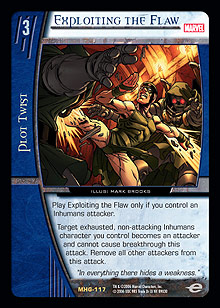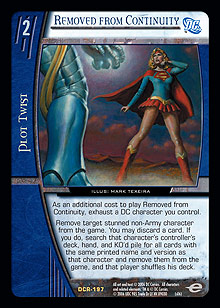A comfortable rumble of rolling dice, declared attacks, and card-related conversation fades to silence. That black box opens and your mind slips quietly into its deepest concentration. The plastic sleeves slide effortlessly between your fingertips. The red numbers on a black digital clock tick down toward the conclusion of the round. A judge stares intently. Onlookers stare intently. You proceed through your mental checklist, weigh the risks and potential rewards, and prepare for the onslaught.
The board presence appears equal, with your characters supporting the aggressive edge. Formation-breaking blows run though your mind as you calculate the effects of mass damage. This game will be over in the next two turns for better or worse, and this is the time to start your kick. It is time to deal the deathblow, to grab the board presence, to initiate the beginning of the end. You lean in close to your cards and whisper a victory song.
Declarations are made, combat modifiers are applied and resolved, and you guide your forces into the fray. You drift forward in your seat, the crowd shuffles in anticipation, and your opponent’s head drops into a submissive position. That cool copper taste rolls across the back of your throat. You can actually smell the fear. You wage an all-out boar-rush for the kill.
Then it happens. Your eager aggression slips to confusion and the back of your neck begins to burn. Like a rattlesnake sliding into a soft, dark sack, you realize what has happened. The calm concentration gives way to that pounding in your hands. It travels up your arms, to your face. Your heart sinks.
Your opponent drops a defensive plot twist. You respond with a bigger attack, but the walls are raised and the ramparts secured. Your opponent drops twist after twist and piles on the DEF modification until you have nothing left. When the chain clears and the totals are tallied, your aggressive assault leaves you stunned after facing an insurmountable defensive stand. Brickwalled FTL.
Disrupting the Win Condition
After a key attack stalls out during a crucial part of a game, the momentum typically shifts. You can leave an opponent spent and with few options. In the best-case scenarios, your opponent swings in with a huge attacker, but you stun it and are left standing. Not only does your opponent walk away with the only endurance loss from the exchange, but he or she now also has to face the wrath of an additional character that might be able to swing directly to the face.
The history of this game shows us that the primary win condition sought by the majority of decks involves causing endurance loss by attacking. From the Big Brotherhood decks of the game’s origins to the ever-changing Faces of Evil, attacking for the win seems to be very popular. In most formats, the best players give their first attention to the very best battle decks. If you are looking to crack a new format, it is well worth your time and effort to exploit the biggest characters, the best ATK pumps, and those synergies that aid in the aggressive destruction of an opponent’s endurance total.
Disrupting the Attack
 Still, there is a great deal of satisfaction to be found in disrupting popular archetypes and Exploiting the Flaw of the aggro decks. It may be useful to evaluate the motives and means of an aggressive deck. Often, these decks seek board dominance and attempt to stomp on your head with brutal attack tactics. In the sport of Judo, a competitor is taught to take the opponent’s momentum and redirect it in a desired direction.
Still, there is a great deal of satisfaction to be found in disrupting popular archetypes and Exploiting the Flaw of the aggro decks. It may be useful to evaluate the motives and means of an aggressive deck. Often, these decks seek board dominance and attempt to stomp on your head with brutal attack tactics. In the sport of Judo, a competitor is taught to take the opponent’s momentum and redirect it in a desired direction.
Cards like Overload and System Failure thrive on aggressive momentum to disrupt an attack. Players find themselves penalized for extensive ATK modifiers. In other cases, a defensive deck might build its own sort of momentum by gathering the resources to make attacks fail. At other times, decks work to eliminate the opponent’s opportunity to attack by exhausting his or her characters (via Mystical Paralysis or Puppet Master, for example), taking away team affiliations via cards like Tower of Babel, or otherwise restricting the value of potential attackers (with cards like Pleasant Distraction or Mind Control).
All of these methods are forms of disruption that interfere with the establishment of the conditions necessary to achieve the win in an attack-centric deck. Without attacks, attackers, or ATK power, aggro decks find themselves anemic and struggling to compete.
Disrupting the Game Plan
A weenie rush deck can sometimes impair a stall deck’s ability to reach later turns. In contrast, most decks seeking the late game attempt to restrict the effectiveness of an early aggressive assault. In both cases, decks require some sort of technique for the disruption of competing win conditions. If you are playing a deck like Faces of Evil, you are typically not seeking to drop seven or eight resources and may find yourself defeated after going to very late turns in a game.
Many weenie and short-curve decks have taken to the inclusion of burn cards to secure an early win against other decks. In a sense, they disrupt the game plan or win condition of late game decks by denying them the opportunity to use powerful, late game attackers and some late game effects. Decks like Doom Bomb and X-Stall have fallen from favor because it has become increasingly difficult to establish the win condition for those decks when facing aggro-burn powerhouses like High Voltage.
Still, late game decks like the $10K Minneapolis Donkey Club stall deck and decks packing Psycho-Pirate have found success by limiting the establishing conditions for short-curve wins. It is very difficult to have a weenie rush when all of the low cost characters are knocked off the board. Flame Trap, Reign of Terror, Absolute Dominance, and Total Anarchy all work to reduce the number of low cost characters running around on the board. Recent additions to this pool (like Worldship) may make an appearance at Pro Circuit Los Angeles in November.
Disruption through Removal
 Ian Vincent disrupted a number of well-laid plans at PC: San Francisco through the use of cards like Sarge Steel and Talia, Daughter of Madness, but the most debilitating sort of disruption occurs when key components of your deck’s win conditions are voided or totally removed. If you are running a deck that relies on the continual activation of Dr. Light, Master of Holograms, then a card like Finishing Move or Removed from Continuity can sing your proverbial swan song.
Ian Vincent disrupted a number of well-laid plans at PC: San Francisco through the use of cards like Sarge Steel and Talia, Daughter of Madness, but the most debilitating sort of disruption occurs when key components of your deck’s win conditions are voided or totally removed. If you are running a deck that relies on the continual activation of Dr. Light, Master of Holograms, then a card like Finishing Move or Removed from Continuity can sing your proverbial swan song.
New School and Deep Green were very successful deck archetypes because they worked toward their own win conditions while removing pieces of competing win conditions. Merlyn and the 6-drop Dr. Light may be tricky to “turn on” or use, but they offer the greatest reward. This game does not offer many opportunities for the ruthless stunning or removal of opposing characters, but most cards that disrupt opposing boards in this way are very valuable. I have a small box that contains twelve copies of the uncommon gem Mikado and Mosha. Character cards that stun and/or remove other character cards can be incredible.
Kaboom!
During our War of Attrition, I had a blast replacing your precious little cards and all you got was a glance at my Reality Gem. If that sentence made you smile or groan, then you know about the variety of cards designed to disrupt opponents by replacing their important locations, Team-Ups, and ongoing plot twists. These types of cards tend to be a reaction to very powerful deck types that rely heavily on a given type of resource. In the old days, we used to pay a heavy price for Have a Blast!, and I relocated more than a few Avalon Space Stations. Today, I might plan to knock out multiple copies of Act of Defiance and Faces of Evil, or may just want to smack your Dr. Fate’s Tower. It is clear how this disruptive subgroup can cramp an opponent’s style.
Denial
To wrap up this list of disruptive groups, we conclude with the lurid use of total denial. I had a friend once that became a serial card player because he was denied the opportunity to search for his 4-drop. Fizzle, The Conclave, Latverian Embassy, and Time Gem all get together to reject the shots thrown up by fellow card flippers. Right behind that little stack of Mikado and Moshas sits a shiny play set of Null Time Zones. These cards are somewhat similar to the last class of disruptive cards because they are very reactive. I am not a very reactive player, but I agree that these cards may have a place in some metagames. They have fueled—or supplemented the fueling of—some PC Top 8 decks like Xavier’s Dream, New School, and Blackbriar Thorn abuse.
The next time you start to feel that calm, collected confidence, it may be worth checking your mental list for possible types of disruption that foil your plans. Better yet, it may be worth testing out these various forms of disruption during your prep for the next tournament. When you have established the front-runners for a given metagame, you will grow as a player if you go that extra step and consider the options for disrupting their win conditions. This becomes an essential part of a testing protocol. You create a deck, note the tech that might interfere with victory, and occasionally pack your own disruption for the opponent’s attempt at disruption. Do not go overboard. Packing a little disruptive tech may help you smash some faces in your next match.
Class dismissed.
Jeremy “Kingpin” Blair (7-drop, TAWC) is a card flipper and student of the game from the Southeastern part of the United States. If you have constructive comments or questions, feel free to contact him at Tampakingpin@yahoo.com.